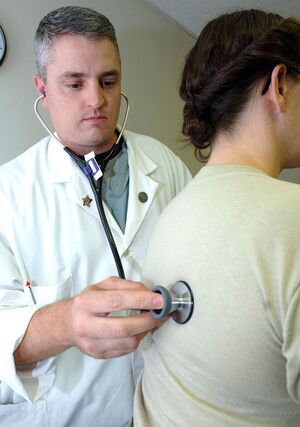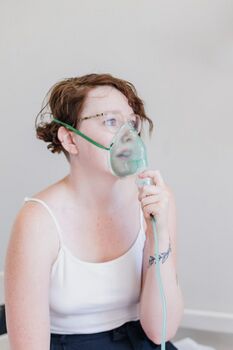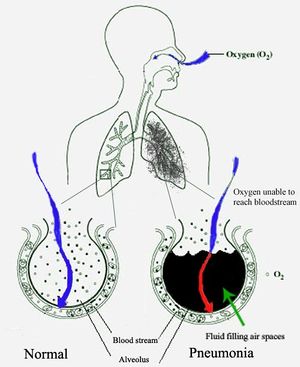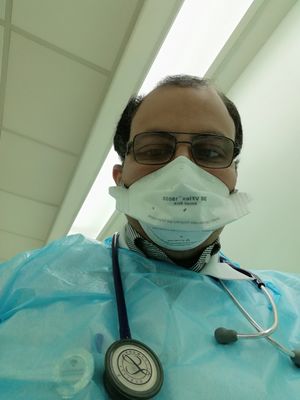Respiratory Disorders
Original Editor - Lucinda hampton
Top Contributors - Lucinda hampton, Simisola Ajeyalemi and Kim Jackson
Introduction[edit | edit source]
Respiratory disease are any of the diseases and disorders of the airways and the lungs that affect human respiration.[1] Any part of the respiratory system may become infected or diseased and the effects may have a wide variety of complications. The response to infection, as else where in the body, is an inflammatory reaction. As a result hyperaemia and swelling of the mucous lining occur causing difficulty in respiration and a degree of hypoventilation. Fibrosis occurs if the condition becomes chronic, resulting in a loss of elasticity, with possible permanent decrease in ventilation. The oxygen uptake is impaired and carbon dioxide accumulates. The tissues no longer perform as well and general health is impaired, with the patient easily fatiguing.[2]
Alongside the inflammatory reaction, there is increased mucus secretion, resulting in obstruction of the airways with collapse of the lung tissue distal to the block. It is of paramount importance to regain expansion of the area as soon as possible because the collapsed tissue becomes fibrosed, with permanent reduction of the ventilation capacity of the lungs.
Types of Respiratory Disorders[edit | edit source]
There are two types of respiratory diseases and disorders: Infectious and Chronic.
- Pulmonary infections are most commonly bacterial or viral. In the viral type, a pathogen replicates inside a cell and causes a disease, such as the flu.People with weakened lungs and immune systems are more vulnerable to infectious respiratory conditions
- Chronic lung diseases, fall into one of two main classes: Obstructive or Restrictive[3][4].
Global Burden: Respiratory diseases are leading causes of death and disability in the world.
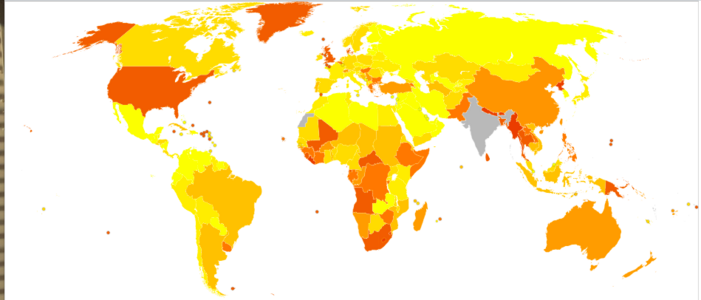
Chronic Respiratory Disorders[edit | edit source]
Chronic respiratory diseases (CRDs) are a group of chronic diseases affecting the airways and the other structures of the lungs. Hundreds of millions of people around the world suffer from preventable chronic respiratory diseases.[5]See also Category:Chronic Respiratory Disease - Conditions
Alongside tobacco smoke, other risk factors include air pollution, occupational chemicals and dusts, and frequent lower respiratory infections during childhood. CRDs are not curable; however, various forms of treatment that help open the air passages and improve shortness of breath can help control symptoms and improve daily life for people living with these conditions.[6]
Obstructive Conditions: involve blocked or narrowed airways, making it difficult for the lungs to exhale and exchange old air for fresh air. eg.
- Chronic obstructive pulmonary disease An estimated 65 million people have moderate to severe chronic obstructive pulmonary disease (COPD), from which about 3 million die each year.
- Alpha-1 antitrypsin deficiency
- Asthma About 334 million people suffer from asthma [4], which is the most common chronic disease of childhood, affecting 14% of children globally. The prevalence of asthma in children is rising
- Bronchiectasis ,
- Cystic fibrosis.
Restrictive Conditions: reduces the volume of air that the lungs can hold. Lungs can lose their elasticity or the ability to expand.eg
- Pulmonary fibrosis,
- Sarcoidosis,
- Lung cancer[3]The most common lethal neoplasm in the world is lung cancer, which kills 1.6 million people each year ; and the numbers are growing.[7]
Infectious Conditions[edit | edit source]
Infectious lung conditions are usually temporary, although some respiratory infections can become chronic or frequently recur. For decades, acute lower respiratory tract infections have been among the top three causes of death and disability among both children and adults.[7] Pulmonary infections are common and are caused by a wide range of organisms. Causes include:
- Pulmonary viral infection
- Pulmonary bacterial infection: bacterial pneumonia
- Pulmonary mycobacterial infection: pulmonary tuberculosis; pulmonary nontuberculous mycobacterial infection
- Pulmonary fungal infection: pulmonary aspergillosis [8]
The Future[edit | edit source]
Respiratory diseases are an enormous challenge to life, health and productive human activity.
- Prevention, control and cure of these diseases and promotion of respiratory health must be a top priority in global decision making in the health sector.
- The control, prevention and cure of respiratory diseases are among the most cost-effective health interventions available.
- Investment in respiratory health will pay manifold dividends in longevity, healthy living days and national economies.
Respiratory diseases are mostly caused by genetic and environmental factors and/or social behaviors that lead to lung inflammation, injury and remodeling, and progressive deterioration of lung function.
- Despite progress in understanding the pathological mechanisms involved in each of these disorders, there is still no effective therapy able to halt their natural history or reverse the morphological and functional injury already established. At end-stage lung disease, lung transplantation remains the only feasible intervention.
- The gut–lung axis has emerged as a specific axis with intensive dialogues between the gut and lungs, involving each compartment in a two-way manner, with both microbial and immune interactions . The lung microbiota is now recognized as a cornerstone in the physiopathology of numerous respiratory diseases[9].
- Research in respiratory diseases is the hope for today and the promise for tomorrow. Research must answer many questions: how do lung diseases arise, how do they are spread, who is vulnerable, and what actions can be used control or cure them, to name a few.[7]
Physiotherapy[edit | edit source]
See specific disease link and Respiratory Disease - Conditions Respiratory System - Assessment and Examination Respiratory Disease - Interventions
References[edit | edit source]
- ↑ Britannica Respiratory Disorders Available:https://www.britannica.com/science/respiratory-disease (accessed 22.10.2022)
- ↑ Medical Geek Introduction to diseases of the respiratory system Available:http://www.medicalgeek.com/lecture-notes/8090-introduction-diseases-respiratory-system.html (accessed 22.10.2022)
- ↑ 3.0 3.1 US news Respiratory diseases Available from:https://health.usnews.com/conditions/respiratory-disease (accessed 7.5.2021)
- ↑ Visible body Respiratory diseases Available from:https://www.visiblebody.com/learn/respiratory/diseases-and-disorders (accessed 7.5.2021)
- ↑ WHO Chronic respiratory diseases Available from:https://www.who.int/gard/publications/chronic_respiratory_diseases.pdf (accessed 7.5.2021)
- ↑ WHO Chronic Respiratory Diseases Available:https://www.who.int/health-topics/chronic-respiratory-diseases#tab=tab_1 (accessed 22.10.2022)
- ↑ 7.0 7.1 7.2 FIRS The Global Impact of Respiratory Disease Available from:https://www.who.int/gard/publications/The_Global_Impact_of_Respiratory_Disease.pdf (accessed 7.5.2021)
- ↑ Radiopedia Pulmonary Infection Available:https://radiopaedia.org/articles/pulmonary-infection (accessed 22.10.2022)
- ↑ Enaud R, Prevel R, Ciarlo E, Beaufils F, Wieërs G, Guery B, Delhaes L. The gut-lung axis in health and respiratory diseases: a place for inter-organ and inter-kingdom crosstalks. Frontiers in cellular and infection microbiology. 2020 Feb 19;10:9.Available from: https://www.frontiersin.org/articles/10.3389/fcimb.2020.00009/full (accessed 8.5.2021)
